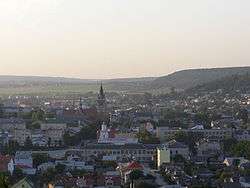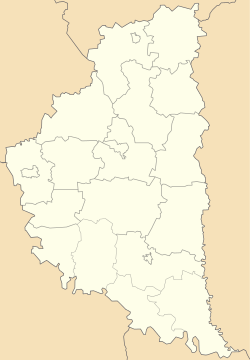Chortkiv
Chortkiv (Ukrainian: Чортків; Polish: Czortków; Yiddish: טשאָרטקאָוו Chortkov) is a city in Ternopil Oblast (province) in western Ukraine. It is the administrative center of the Chortkiv Raion (district), housing the district's local administration buildings.
Chortkiv Чортків Czortków (in Polish) טשאָרטקאָוו (in Yiddish) | |
|---|---|
City of regional significance | |
 View of Chortkiv and the surrounding Podolian landscape. | |
 Flag Coat of arms | |
 Chortkiv Location of Chortkiv in Ukraine  Chortkiv Chortkiv (Ukraine) | |
| Coordinates: 49°00′27″N 25°47′26″E | |
| Country | |
| Oblast | |
| Magdeburg rights | 1533 |
| City status | 1939[1] |
| Government | |
| • City Mayor | Volodymyr Shmatko |
| Area | |
| • Total | 30 km2 (10 sq mi) |
| Elevation | 218 m (715 ft) |
| Population (2018) | |
| • Total | 29 057[3] |
| Time zone | UTC+2 (EET) |
| • Summer (DST) | UTC+3 (EEST) |
| Postal code | 48500—48509 |
| Area code | +380 3552 |
| Website | |
Chortkiv is located in the northern part of the historic region of Galician Podolia on the banks of the Seret River.[1][4]
In the past Chortkiv was the home of many Hasidic Jews; it was a notable shtetl and had a significant number of Jews residing there prior to the Holocaust. Today, Chortkiv is a regional commercial and small-scale manufacturing center.[4] Among its architectural monuments is a fortress built in the 16th and 17th centuries[5] as well as historic wooden churches of the 17th and 18th centuries.[6]
History
The first historical mention of Chortkiv dates to 1522[1], when Polish King Sigismund I the Old granted an ownership order for Jerzy Czortkowski over the town and allowed him to name it after himself—Czortków.[6] The small community, numbering at 50 families, were almost all massacred during the Chmielnicki Uprisings of 1648–9. Jewish leadership opposed the resettlement of Jews in Chortkiv until 1705.[7] During that time, the town was also granted Magdeburg rights.[4] However, Chortkiv would later decline in the second half of the 17th century during Ottoman Expansion of central Europe. The town was taken over by Ottoman Empire,[4] whose rule lasted 27 years. It was part of the short-lived Turkish Podolia Eyalet, which lasted from 1672 to 1699. During this period, it was nahiya centre in Yazlofça sanjak as Çortkuv (Spelled as Chortkoov in Turkish).[8] After First Partition of Poland Chortkiv came under Austro-Hungarian rule which lasted from 1772 to 1918, during the time of which it was the center of the Chortkiv Bezirk except brief Russian rule between 1809 and 1815 as part of Tarnopol Governorate. On June 8, 1919 the Ukrainian Galician Army broke for couple months through the Polish front at Chortkiv and began the Chortkiv offensive.[4] Soon afterwards, the town was seized by the Poles. It was ceded to sovereign Poland in the Peace Treaty of Riga between Poland, Soviet Russia (acting also on behalf of Soviet Belarus) and Soviet Ukraine, and remained part of the Tarnopol Voivodeship of the Second Polish Republic until the Soviet invasion of Poland in September 1939.
In 1931, the town had 19,000 inhabitants, 22.8 percent of whom were Ukrainians (Greek Catholics), 46.4 percent of whom were Poles (Roman Catholics), and 30 percent of whom were Jews. Chortkiv was an important garrison of the Polish Border Defence Corps Brigade "Podole", whose commandant from 1935 to 1938 was General Stefan Rowecki. Furthermore, it was home to the 36th Reserve Infantry Division.
The town was annexed to the Soviet Union from September 17, 1939 until June 1941. Its Polish inhabitants, particularly students of the local high school, organized a failed uprising in January 1940,[9] which would serve as the first Polish uprising of World War II. From 1941-1944 it was annexed to Nazi Germany. After the defeat of the Nazis by the Red Army in 1944, the town returned to Soviet control until in 1991 it became part of independent Ukraine. Polish residents of the town were transferred to the Recovered Territories in the immediate postwar period (see Polish population transfers (1944–1946)).
Due to heavy destruction of Ternopil, in 1944 Chortkiv served as a regional seat.[10]
In January 1989 the population was 26 681 people[11][1].
In January 2013 the population was 29 640 people.[12]
People from Chortkiv
- Kateryna Rubchakova (1881–1919), Ukrainian actress and singer
- Maria Maciyivska (born 1918), first soprano Leeds Church Toronto, Ontario 1954 - 2008.
- Sacha Blonder (André Blondel) (1909-1949), Ecole de Paris painter
- Waclaw Czerwinski - Polish engineer and pilot, pioneer of Polish gliding,
- Jerzy Czortkowski, founder of Chortkiv
- Pinchas Horowitz (1731–1805), rabbi and Talmudist
- Jerzy Janicki (1928-2007) – Polish writer and reporter,
- Edward Kmiecik (born 1928) - Polish painter,
- Ireneusz Opacki (1933-2005) – academic of the Katowice Silesian University, expert on Polish literature,
- Jerzy Przystawa (born 1939) - Polish scientist, physicist,
- Alfred Trawinski - major of the Polish Army, doctor and professor of Medicine Academy of Lwow,
- Tadeusz Wazewski (1896-1972) – Polish scholar, mathematician, professor of Jagiellonian University,
- Shmelke of Nikolsburg (1746–1778), one of the great early Chasidic Rebbes
- Karl Emil Franzos (1848–1904), Austrian novelist
- Leopold Levytskyi (1906–1973), Ukrainian painter
- Perla (Penina) Richter Feldschu (1900-1943), Warsaw musicologist, wife of Zionist activist Ruben Feldschu (Ben Shem)[13]
- Bernard (Berl) Hausner (1874-1938) father of Gideon Hausner. Gideon was the Prosecutor of Adolf Eichmann, and Attorney General of Israel. Bernard was a Rabbi in Lemberg, Polish consul to Palestine, and Zionist. Migrated to Israel in 1927.
Gallery
- City hall
- Belltower of Assumption Church in Chortkiv
 Historic county court building
Historic county court building- Ruins of Chortkiv Castle and Regimental Church
- St. Stanislaus Church
- Hasidic synagogue of Chortkiv
- Railway station
 Chortkiv House of Culture
Chortkiv House of Culture City centre and the old Town Hall in Chortkiv
City centre and the old Town Hall in Chortkiv.jpg) Football Match at Stadium in the city Chortkiv, 1938
Football Match at Stadium in the city Chortkiv, 1938
See also
References
- Чортков // Большой энциклопедический словарь (в 2-х тт.). / редколл., гл. ред. А. М. Прохоров. том 2. М., "Советская энциклопедия", 1991.
- "Chortkiv (Ternopil Oblast, Chortkiv Raion)". weather.in.ua (in Ukrainian). Retrieved 2 February 2012.
- Чисельність наявного населення України на 1 січня 2018 року. Державна служба статистики України. Київ, 2018. стор.64
- "Chortkiv". Encyclopedia of Ukraine. Retrieved 3 February 2012.
- "CHORTKIV CASTLE, 1610". Halychyna! - Homeland Page. Central European University Personal Pages. Retrieved 3 February 2012.
- "Foundations of history". chortkiv.com.ua (in Ukrainian). Unicom ISP. Retrieved 3 February 2012.
- "Jewish History of Chortkiv". Beit Hatfutsot Open Databases Project, The Museum of the Jewish People at Beit Hatfutsot.
- http://i.piccy.info/i9/50c7ec080439bb1790d77fec4b180a08/1437042927/139143/831035/The_Eyalet_of_Kamanice.jpg Map of Podolia Eyalet
- Gross, Jan Tomasz (2002). Revolution from Abroad: The Soviet Conquest of Poland's Western Ukraine and Western Belorussia. Princeton University Press. p. 172. ISBN 0-691-09603-1.
- Snitovsky, O. Five centuries of Ternopil. The city of Hetman Jan and mason Leontiy. Ukrinform. 28 August 2015
- Всесоюзная перепись населения 1989 г. Численность городского населения союзных республик, их территориальных единиц, городских поселений и городских районов по полу
- Чисельність наявного населення України на 1 січня 2013 року. Державна служба статистики України. Київ, 2013. стор.96
- Laurence Weinbaum "'Shaking the Dust Off". The Story of the Warsaw Ghetto’s Forgotten Chronicler, Ruben Feldschu (Ben Shem)" Jewish Political Studies Review 22:3-4 (Fall 2010)
8. Czortków KehilaLinks Site - JewishGen http://kehilalinks.jewishgen.org/Suchostaw/sl_czortkow.htm
External links
| Wikimedia Commons has media related to Chortkiv. |
- "Main - Informational-Entertaining site of Chortkiv". Chortkiv.te.ua. Archived from the original on 6 January 2012. Retrieved 3 February 2012.
- Miri Gershoni Shifris, Site dedicated to city Jews